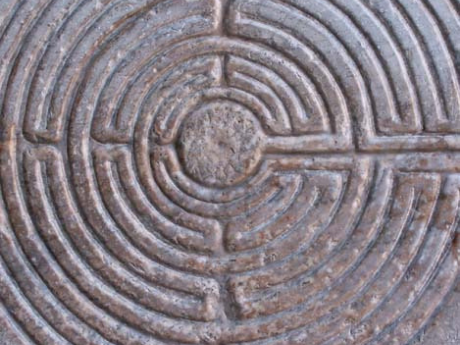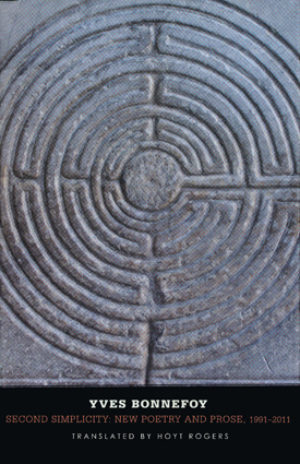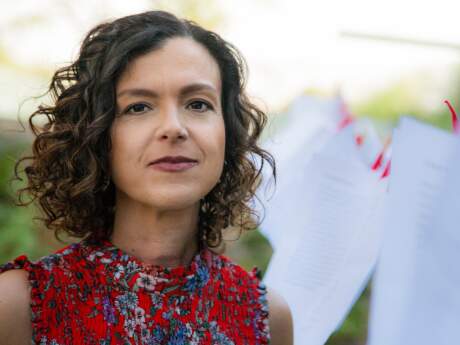In Their Own Words
Hoyt Rogers on Yves Bonnefoy and Translating “Just Before Dawn...”

Just before dawn...
Just before dawn
I look through the window: the snow
Must have stopped. A swath of blue,
Gleaming in front of the trees,
Laps at the walls of night.
I go outside,
Picking my way down the wooden steps,
Caked high with the new-fallen snow.
My ankles are ringed by the piercing chill;
It seems to clarify the mind,
Which starts to hear the silence of things.
I wonder if the chipmunk,
Our simple neighbor, is still asleep—
Or has he already left
The tangled woodpile by the sill
To rove through the crackling cold?
I notice tiny tracks before the door.
Translated by Hoyt Rogers
From Second Simplicity: New Poetry and Prose, 1991-2011, translated by Hoyt Rogers (Yale University Press, 2012). All rights reserved. Reprinted with the permission of the translator.
On Yves Bonnefoy and translating "Just Before Dawn..."
Now approaching ninety, Yves Bonnefoy is often acclaimed as France's greatest contemporary author. In selecting and translating the pieces for Second Simplicity, an anthology of his recent verse and poetic prose, I have been profoundly impressed by his enduring freshness of vision, his unabated will to set out anew. Perhaps it is only an American perspective, but I would consider New England in wintertime the "primal scene" of his past two decades—arguably the most innovative period of his entire lifework. This is the landscape that inspired Beginning and End of the Snow, the 1991 collection in which "Just before dawn..." was first published. Dickinson, Hawthorne, Melville, Thoreau, and Frost have informed Bonnefoy's attachment to the region, where he has spent several long sojourns. I would posit that its quiet woods and fields, rustic and unadorned, initially gave shape to the pared-down aesthetic of his latter years. For Bonnefoy, every snowfall is an emblem of his words, swirling and ephemeral. When the snow stops—as in the opening stanza of "Just before dawn…"—the blank sheet outside his window gleams like an unwritten page.
Beginning and End of the Snow includes a cluster of short poems which reveal Bonnefoy's affinity to the compact verses of Dickinson, Melville, and Frost, with their frequent flashes of humor. The four poets are similar in their metaphysical scope; and thematic links ineluctably arise from their rapt contemplation of the same surroundings. The appearance of the chipmunk—that quintessentially American animal—in the final strophe of "Just before dawn…" recalls key poems by Bonnefoy's New England predecessors. Dickinson's "A Bird came down the Walk…" and "A narrow Fellow in the Grass…" immediately spring to mind: she deftly conveys the behavior of small creatures as they move along the ground, treating them as familiars—our "humble neighbors," to borrow Bonnefoy's phrase. Frost, in poems such as "Range-Finding" and "Design," reduces the dimensions still further, to the minute level of spiders, moths, and flies, ironically bringing out the vast disquiet they can instill—though Dickinson's snake also provokes "a tighter breathing / And Zero at the Bone." When writing verse, Melville often rivals her in bold eccentricity; but for all his quirky diction, he foreshadows Bonnefoy in his sidelong glimpse of a chipmunk, "Prying, peeping / From Beech-tree; / Crickling, crackling…"
Another presence in "Just before dawn…" comes from much farther afield: Matsuo Basho. The acute awareness of nature in Japanese poetry often extends to animals; in Basho's haiku we encounter not only the celebrated frog, but also cicadas, mosquitoes, butterflies, grebes, and even boars—introduced less for their pictorial qualities than for their catalytic evanescence. In Bonnefoy's poem, the piercing chill "seems to clarify the mind, / Which starts to hear the silence of things." Such moments of heightened stillness mark The Narrow Road to the Deep North, a book that alternates poetry and prose as Bonnefoy has done in several late works. His own journey to the "deep north" of New England has allowed him to wend his way through an inner as well as an outer geography, an amplified interior. For both writers, such departures are integral to poetry itself, which remains dauntless in the face of death. In their diverse idioms, they could both subscribe to Whitman's terse envoi: "The untold want by life and land ne'er granted, / Now voyager sail thou forth to seek and find."
Bonnefoy unexpectedly invokes the Japanese poet in a fantasia on Hamlet at the end of Second Simplicity: "an old sage in traveling dress… Basho, always benevolent." A sentence or two later, he depicts Shakespeare himself walking through "the stones of time, the voices of space," the universal realm of literature. Bonnefoy is the preeminent translator of English poetry into French, and his insights into our language have often aided me in my task. In every transposition, some facets are lost but others are found, because the target language has its own riches to offer. The translated poem can best be understood as an extended metaphor that shifts the terms of the original into a different linguistic field. If poetry is essentially the art of metaphor—of word to word, image to image, sound to sound—then translation participates in its founding creative act. By summoning the poem into another language, the translation frees it to traverse another culture, another world. From writer to page, page to reader, language to language, we constantly pass from one translation to another, and to another yet again. At every port of call, some words embark and others disembark, but the voyage of translation never ends.



